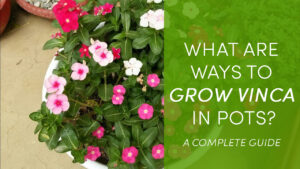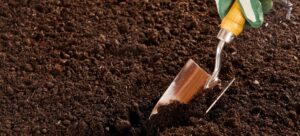Table of Contents
 You might have noticed a lot of vinca flowers in southern households and gardens. Vinca flowers can survive easily in the sun because they are tolerant to heat to a great extent. As the plant keeps growing from the early summer and keeps growing till late fall, many people plant these flowers.
You might have noticed a lot of vinca flowers in southern households and gardens. Vinca flowers can survive easily in the sun because they are tolerant to heat to a great extent. As the plant keeps growing from the early summer and keeps growing till late fall, many people plant these flowers.
One of the most common practices to plant vinca flowers is in pots. People put them in pots to enjoy the long-lasting blooms of these flowers through the summer and fall seasons. Also known as periwinkle, vinca flowers belong to Madagascar. These flowers require very minimal maintenance and can grow in extreme environmental conditions easily. If you are looking for answers to certain questions for growing vinca flowers, you are on the right page. This article will answer all your queries regarding planting vinca flowers in pots.
Fortunately, we have enlisted all the details for ways to grow vinca in pots.
Read more about: How to Get Rid of Ants in Vegetable Garden: Save Your Crop
Plantation and maintenance tips to grow vinca in pots.
The beautiful vinca flowers bloom in many different colors. White, purples, pink, and orange vinca flowers are one of the most common colors. The flowers are substantially drought tolerant. You can either plant them around the borders of your lawn/garden or in the containers. They can easily grow to the height of 10-18 inches in length. The flowers usually contain 6-8 petals and look so aesthetic to the eyes.
Step 1. Plant vinca at the right time.
Vinca usually grows without any extra effort. It is crucial to plant the vinca at the most appropriate time to extract the best growth out of the plant.
Gardeners recommend planting them in pots in early spring or fall. Most of the plants grow the best when the spring season is around. By the start of the year, when the season is moderate, you can easily grow the plant in the best possible conditions.
The periwinkle flowers grow in more stable seasons. People need to understand that not all vinca plants grow at much length. Some plants are genetically short in height. You can plant these trees on the ground. If you want to grow the plants in pots, ask the gardener with plants that have more length genetically.
In cold regions, the vinca plants act more like annual plants. The vinca flowers grow and the cycle completes in a year. However, if you plant the flowers in hot areas, you will observe the flowers behave like perennial ones.
Step 2. Prepare the soil.

It is crucial to note that vinca flowers do not come out in gardens or normal soil. You have to prepare the soil for it. You can mix compost or other organic materials with soil to plant vincas.
You can also follow this measurement.
- Take a well-drained container/pot that has a drainage hole in it.
- Put a stone on the drainage hole and cover it.
- Add 45% of normal soil to the pot.
- Now add 20-25% of organic compost in the normal soil pot and mix well.
- Add 20% coco peat to the soil and compost and mix them together.
- Now add 20% of fine sand and add it to the same pot.
 Otherwise, there are commercially available soil mixes as well. Go to a nursery and get the commercial compost for the pot. The soil in the garden does not drain. The garden soil can, later on, cause rotting issues to the root of the plant and growth hinders. If you are planting vinca in a container with other flowers or plants, keep the vinca on the side. Later on, vinca will grow and the size of the plant can get the space to spread on the sides. Moreover, if you want to plant two or more vincas in one pot, make sure to plant them at a distance of at least 7 inches.
Step 3. Plant the vincas in pots or containers.
Once you have prepared the pot with commercial soil, plant the vincas in it. Make sure you do not damage the roots or stem of the plant before planting it in the drainage pot. Follow these instructions
- Take the plant that is present in the polybag.
- Gently take it out, without causing any damage to the roots of the plant.
- Make a hole in the center of the soil in the pot.
- Now put the plant in this hole.
- Now put the extra soil in the pot and fill it 2 inches to the surface.
- Water the plant slightly.
- Add a thin layer of mulch to the surrounding areas of the soil.
- The mulch will help the soil to train its moisture.
- It will also control the growth of extra weed in the pot.
- Â Over time, mulch will decompose. Then it will add more nutrients to the soil of the plant and ultimately to the plant.
Step 3. Sunlight

Once you have prepared the pot, keep it in partial sunlight for a few days. Let the soil and plant set in. Once roots start growing and amalgamate with the new soil mixture, you can move it. After a few days, move the pot in the full sunlight. Do not place the pot in the sunlight right after planting the vinca. Vinca plants can turn dry and rot.
Step 4. Fertilizers
If your soil is good enough, you might not need to add much fertilizer to it. However, if you want to get the best results, add fertilizers to it. It is the best practice to add fertilizers after every 20-25 days. Do not add excess fertilizer to your small pot. Add organic compost as a fertilizer for vincas. If it is not available you can also go with general-purpose fertilizers.
Step 5. Watering frequency
Follow a frequent routine to water the plant. Water frequency may change from season to season. The best practice is to check the soil.
- Take a stick or your finger and dip it around 1 inch in the pot.
- If the surface is dry, add water to the pot.
- If you notice moisture in the surface, you can wait for a day or two unless you feel that the soil surface is dry.
- In summers, water evaporates more quickly and you have to pour in water regularly.
- In winter moisture stays in the pot for a long time. In winters you do not have to water the plant quite often.
Step 6. Insects/diseases
Vincas usually do not get a lot of diseases. In winters if the moisture is more than the need of the plant, it can allow mildew to grow. In such cases keep extra care of moisture conditions in the pot.
In case you observe any insect or diseases on the plant, you use an insect repellent and spray it slightly on the plant. If commercial repellents are not available, you can use home-based repellents. Taking neem oil spray or garlic spray can keep the insects away from Vince plants.
Conclusion
Vincas are easy to grow in the pot. The flowers are strong enough to survive in extreme conditions. You can grow the vincas in commercial soil or a mixture of soil mentioned above in the article. Place it and water according to the climate demands. If it’s winter, waterless. If the summer is around, you might need to water more often. Use fertilizers after 20-15 days. Vincas have small variants as well. If the plant is small, grow it on boundaries. However, the long variant of vincas looks so beautiful in pots.
